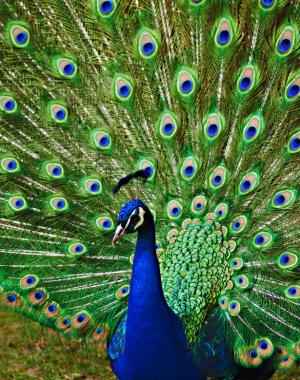How does ostentatious traits of males evolve?
For Charles Darwin, the peacock's tail in terms of natural selection made him extremely uncomfortable.
In fact, once in 1860, writing to his dear American friend, Darwin confessed: 'Whenever I look at a feather on the peacock's tail, I feel sick!'
In an attempt to explain why such seemingly excessive and annoying traits exist, the great English naturalist has thought about sex selection. The ostentatious features like the decoration on the tail are an advantage in the search for partners to help them hide their disadvantages.
A group of Wisconsin scientists has shifted the question from why the ostentatious traits of males exist in the direction they have evolved. They discovered molecular details about how a simple genetic switch could control decorative features on the male fruit fly body, and how the switch evolved. More extensively, their study explains the mechanism by which a male lion has a dreadful mane, male elk with impressive majestic antlers, and male birds have a charming tail.

A beautiful male peacock showed off his tail.(Photo: iStockphoto / Jennifer Daley)
In an article published on the latest issue of August 22, Cell, the research team led by molecular biologist Sean Carroll of the University of Wisconsin - described the principle and evolution of a the fruit fly gene segment allows the male to decorate its belly. Their study also showed how that gene segment regulation in female flies inhibited this phenomenon. Carroll - an investigator from Howard Hughes Medical Institute and one of the world's prominent evolutionary biologists - said: 'The study focused on the question, not the question of why. How does this trait appear in a world but not the other? '
The question of the origin of secondary sexual characteristics - characteristics, not separate reproductive organs in each gender - is a question that embraces modern evolutionary biology, according to Thomas Williams, a partner of University of Wisconsin - Madison co-directed research. 'Males and females basically have the same genome, so how can we alter the activity of the male genome without altering the female genome?'
According to the Cell article, the answer lies in the genetic inhibition of a protein found in male fruit flies that allows males to color the tail at the end of the abdomen.
Carroll said: 'Fruit flies don't need new genes to create new looks. They just need to change the way males and females use the same genome. '
Carrolle stressed, the gene switch that controls protein activity has been around for a long time, it evolved initially with a completely different purpose. But over time the accumulated mutation is probably to respond to sex selection, which has led the male fly evolution towards a more colorful tail . ' The gene switch has existed for tens of millions of years because it once carried on another task. But it was revised. Evolution is an accumulation process. You have this machine, and it's easy to add a bell or whistle. With that special trait, it evolved by exploiting the genetic information available to make the male body different from the female body. '
According to Williams and Carroll, the study did not provide any evidence that the decoration process had ever occurred in children but was later inhibited. 'We have enough evidence to believe that this phenomenon only evolved in males'.
Carroll and Williams argue, the same process occurs in animals from humans to elephants, from seals to fish or beetles. It is a world of hype features in all species. Evolutionary biologists today, like Darwin 150 years ago, are very interested in the question of the benefits they bring.
Carroll explains: 'These are the fastest evolving characteristics. If the child's interests change, the old features disappear. And there is no consolidation. '
Carroll concluded: 'It is balance. As long as what is outdone, those characteristics continue to exist. The color pattern of fruit flies is an example to understand how to use the same genome in two different genders to make different traits'.
- People can 'grow' propellers and cat eyes in the future
- Creatures do not evolve for two billion years
- The brains of males and females are not much different
- New discovery about the evolution of language
- For some males, the smaller the better
- The human brain continues to evolve
- Tibetans evolve the fastest in the world
- Elephants turn into 'murderers' when migrated
- Personality can affect health
- Small males easily become meals for their children
- Males use prongs to mate females
- Discover 3 specific genes that help us evolve into humans!
 Animal 'suffering' after hibernation
Animal 'suffering' after hibernation Why do goats climb well?
Why do goats climb well? Scientists were surprised to see chimpanzees eating turtles
Scientists were surprised to see chimpanzees eating turtles Giant catfish died deadly due to drought in Thailand
Giant catfish died deadly due to drought in Thailand